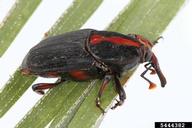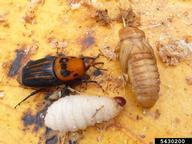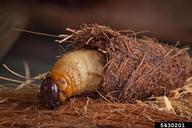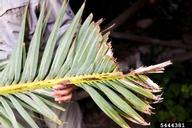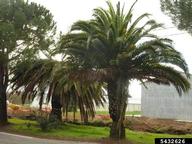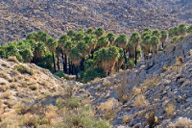Red palm weevil
Rhynchophorus ferrugineus (Olivier) (Coleoptera: Dryophthoridae)
Orientation to pest
The red palm weevil, Rhynchophorus ferrugineus (Olivier), is native to south Asia and Melanesia, where it is a serious pest of palms. Since the 1980s, this weevil has spread rapidly throughout many other parts of the world, reaching the United States (southern California) in 2010. The adult is 2-5 cm long and usually rusty red, but color variants are common. Larvae feed by tunneling in the trunks of palm trees, weakening and eventually killing trees. Red palm weevil is a major pest of date palms (Phoenix dactylifera L.) and coconut palms (Cocos nucifera L.). Palms damaged by red palm weevil show (1) foliage injuries that include straight edges instead of pointed tips, notching of lateral pinnae, and sometimes a linear series of "windows" across pinnae, (2) tunnels in the trunk or at the base of fronds, (3) oozing of viscous fluids from tunnels; (4) frass at entrance of feeding tunnels, (5) empty pupal cases and the bodies of dead adults around heavily infested palms, and (6) breaking of the trunk, or toppling of the palm crown. This weevil is a pest of both cultivation (agricultural or landscaping palms) and native palms in wildlands.
Hosts commonly attacked
The red palm weevil is especially damaging economically to date palms (P. dactylifera) and coconut palms (C. nucifera). Other hosts that have been recorded include palms in the genera Areca, Arenga, Borassus, Caryota, Corypha, Livistona, Metroxylon, Oreodoxa, Sabal, Trachycarpus, and Washingtonia. Of potential concern in the United States is the risk to native palms in the genera Washingtonia and Sabal.
Distribution
Red palm weevil is from south Asia and Melanesia, but since the 1980s, it has spread to Africa, Mediterranean Europe, the Caribbean, and southern California (USA).
Images of red palm weevil
| Figure 1. Adult red palm weevil (dark form found in California), Rhynchophorus ferrugineus | Figure 2. Larva and pupa of red palm weevil (red form of adult, from France) | Figure 3. Red palm weevil lava in open pupal cell |
| Figure 4. Palm frond with typical damage from red palm weevil | Figure 5. Landscape palm damaged by invasive red palm weevils | Figure 6. Native California fan palms, Washingtonia filifera (Lindl.) H.Wendl., at Mountain Palm Springs in Anza Borrego State Park in southern California may be hosts for red palm weevil. |
Important biological control agents related to this pest species
Biological control of the red palm weevil has so far been focused on control methods that can be applied to agricultural palm plantations or landscape palms in urban areas. Should native palms in wildlands be affected, classical biological control (based on importation of parasitoids of the weevil from its native range) should be investigated.
Web links for information on red palm weevil
- The Red Palm Weevil in the Mediterranean Area | M. Ferry and S. Gómez
Article from Vol. 46, No 4, Palms, Journal of the International Palm Society. - Red Palm Weevil Page | Center for Invasive Species Research, University of California, Riverside
- Plant Heatlh Division Target Pest Profile | Department of Food and Agriculture, State of California
Articles
- Murphy, S. T. and B. R. Briscoe. 1999. The red palm weevil as an alien invasive: biology and the prospects for biological control as a component of IPM. Biocontrol News and Information 20 (1): 35N - 46N. (view whole article at http://www.iraqi-datepalms.net/uploadedfiles/review%20article.pdf)
- Faleiro, J. R. 2006. A review of the issues and management of the red palm weevil Rhynchophorus ferrugineus (Coleoptera: Rhynchophoridae) in coconut and date palm during the last one hundred years. International Journal of Tropical Insect 26 (3): 135-154.
